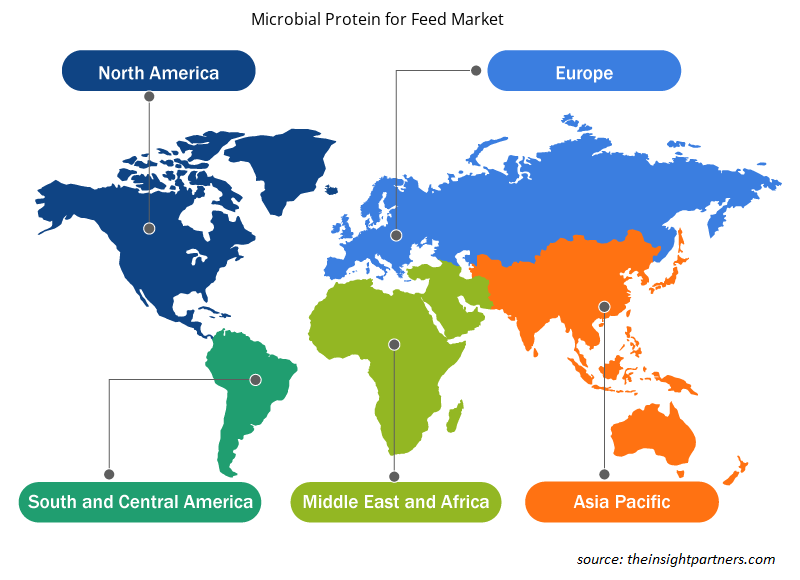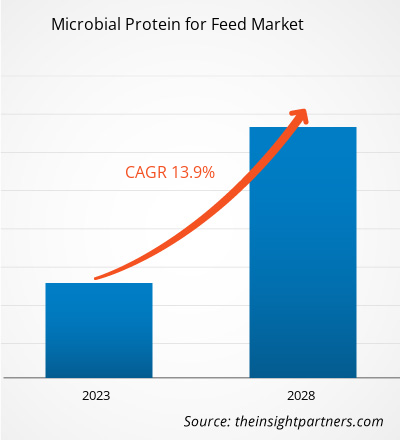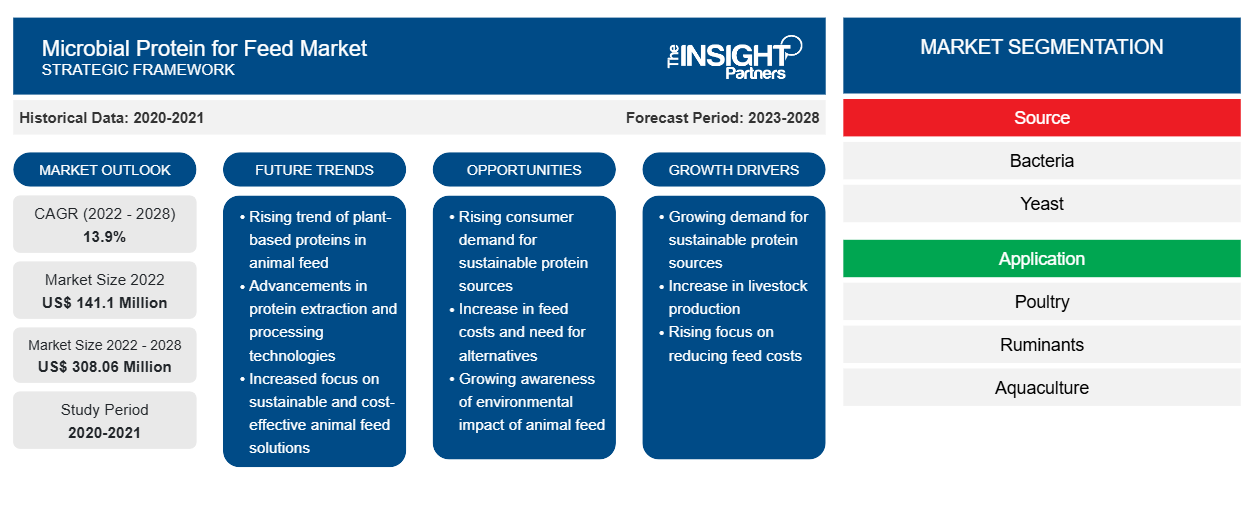饲料用微生物蛋白市场规模预计将从 2022 年的 141,095.88 万美元增长到 2028 年的 308,055.17 万美元;预计 2022 年至 2028 年的复合年增长率为 13.9%。
微生物蛋白是粗蛋白的重要来源之一。在动物饲料中添加微生物蛋白有许多营养益处。微生物蛋白含有 70% 以上的粗蛋白,而豆粕含有 40-50% 的粗蛋白,鱼粉含有 60-65% 的粗蛋白。此外,它具有理想的氨基酸组成,与鱼粉相比,缬氨酸、色氨酸、异亮氨酸和亮氨酸含量更高。微生物蛋白是大豆和鱼粉等传统蛋白质来源的极佳替代品之一。它使用经济高效的底物生产,例如工业气体(二氧化碳、甲烷和天然气)、废水和家禽粪便(羽毛),使用细菌、酵母、真菌或微藻在反应器中发酵。因此,在牲畜饲料中添加微生物蛋白的各种营养益处和日益增长的可持续性问题正在推动饲料用微生物蛋白市场的增长。
2021 年,欧洲占据全球饲料用微生物蛋白市场的最大份额。根据欧洲饲料制造商联合会 (FEFAC) 的数据,尽管非洲猪瘟 (ASF) 在该地区持续蔓延并对养猪业产生了影响,但 2020 年猪饲料产量仍增长了 2.9%。得益于德国的出口禁令,一些欧洲国家增加了对中国的出口,导致 2020 年猪饲料产量激增。随着动物饲料产量的提高,制造商正在寻找可持续的饲料添加剂,因为如今动物源和植物源饲料添加剂并不被视为环保。进口饲料材料(如大豆)威胁着自然资源和生物多样性。因此,动物饲料制造商对微生物蛋白的需求正在增加。
定制此报告以满足您的需求
您可以免费定制任何报告,包括本报告的部分内容、国家级分析、Excel 数据包,以及为初创企业和大学提供优惠和折扣
-
获取此报告的关键市场趋势。这个免费样品将包括数据分析,从市场趋势到估计和预测。
COVID-19 疫情对饲料微生物蛋白市场的影响
饲料行业面临着严峻的挑战,例如原材料和劳动力短缺、原材料价格飙升以及由于全球封锁、旅行禁令、贸易限制、制造单位关闭和其他政府实施的限制而导致的分销网络中断。这阻碍了动物饲料行业各公司的制造活动,从而导致饲料成分价格上涨。在欧盟,约三分之二的成员国指出,在疫情期间畜牧业的饲料价格飙升。此外,在疫情高峰期,中国关闭了大多数地区的牲畜和家禽交易和屠宰市场。畜牧业的这些障碍阻碍了对饲料成分的需求,从而对疫情期间对饲料用微生物蛋白的需求产生了负面影响。
2021年,随着各国政府宣布放宽先前实施的限制措施,各经济体纷纷恢复运营,提振了全球市场。此外,制造商获准满负荷生产,这有助于他们克服供需缺口和其他影响。
市场洞察
政府和私营部门的投资将对饲料市场微生物蛋白的增长产生积极影响
气候变化和对土地和水等自然资源的过度开发是畜牧业和动物饲料行业的主要可持续发展问题。因此,世界各国政府都在资助那些采用可持续做法生产动物饲料和原料的公司,以减少其总体碳足迹并支持循环经济增长。政府和私营部门投资者也在支持那些利用微生物生产动物饲料蛋白的公司,因为微生物是动物营养最可持续的蛋白质来源之一。例如,2022 年 2 月,Arbiom——一家通过加工农业废弃物和木材残渣生产用于动物饲料和食品应用的高质量蛋白质的法美制造商——从法国 Relance 投资计划获得了 1350 万美元的投资。在获得投资后,该公司宣布在法国建造其第一家商业生产工厂。因此,政府和私营部门对饲料用微生物蛋白市场投资的增加预计将在预测期内对市场增长产生积极影响。
来源洞察
根据来源,全球饲料用微生物蛋白市场细分为细菌、酵母和其他。细菌部分在 2021 年占据了全球饲料用微生物蛋白市场的最大份额,预计在 2022 年至 2028 年期间将实现最高复合年增长率。与酵母和其他微生物相比,细菌的生长速度最高。此外,使用细菌培养产生的蛋白质量最大。此外,它含有超过 70% 的粗蛋白,并具有良好的必需氨基酸组成。根据各种研究,1,000 公斤细菌产生的蛋白质质量高于大豆和肉牛。因此,细菌是动物饲料中成本效益高且速度最快的蛋白质来源之一。所有这些因素都在推动该细分市场的发展。
全球饲料微生物蛋白市场的主要参与者包括 Calysta, Inc.、Avecom、Arbiom、KnipBio、ICC 和 Alltech。市场参与者专注于提供高质量的产品以满足客户需求。他们还专注于投资研发活动、合作伙伴关系和扩张等战略。
饲料用微生物蛋白
饲料微生物蛋白市场区域洞察
Insight Partners 的分析师已详细解释了预测期内影响饲料微生物蛋白市场的区域趋势和因素。本节还讨论了北美、欧洲、亚太地区、中东和非洲以及南美和中美洲的饲料微生物蛋白市场细分和地理位置。

- 获取饲料微生物蛋白市场的区域特定数据
饲料微生物蛋白市场报告范围
| 报告属性 | 细节 |
|---|---|
| 2022 年市场规模 | 1.411亿美元 |
| 2028 年市场规模 | 3.0806亿美元 |
| 全球复合年增长率(2022 - 2028) | 13.9% |
| 史料 | 2020-2021 |
| 预测期 | 2023-2028 |
| 涵盖的领域 |
按来源
|
| 覆盖地区和国家 |
北美
|
| 市场领导者和主要公司简介 |
|
饲料市场参与者的微生物蛋白密度:了解其对业务动态的影响
饲料用微生物蛋白市场正在快速增长,这得益于终端用户需求的不断增长,而这些需求又源于消费者偏好的不断变化、技术进步以及对产品优势的认识不断提高等因素。随着需求的增加,企业正在扩大其产品范围,进行创新以满足消费者的需求,并利用新兴趋势,从而进一步推动市场增长。
市场参与者密度是指在特定市场或行业内运营的企业或公司的分布情况。它表明在给定市场空间中,相对于其规模或总市场价值,有多少竞争对手(市场参与者)存在。
在饲料微生物蛋白市场运营的主要公司有:
- 卡利斯塔公司
- 艾维康
- 阿尔比奥姆
- 克尼普生物
- 国际商会
免责声明:上面列出的公司没有按照任何特定顺序排列。

- 了解饲料微生物蛋白市场的主要参与者概况
重点发展:
2022 年 6 月,Calysta Inc. 与安迪苏成立合资企业“Calysseo”,在中国重庆启动其首个工业规模生产设施,每年生产 20,000 吨用于水产饲料的微生物蛋白 FeedKind。随着 FeedKind 在中国的成功生产和分销,合资伙伴计划在未来几年将生产能力扩大到每年 80,000 吨。
报告亮点
- 饲料用微生物蛋白市场的渐进式行业趋势有助于参与者制定有效的长期战略
- 发达国家与发展中国家采取的企业增长战略
- 2020 年至 2028 年饲料用微生物蛋白市场定量分析
- 全球饲料微生物蛋白需求量估计
- PEST 分析说明了影响全球饲料微生物蛋白市场增长的政治、经济、社会和技术因素。
- 了解竞争市场状况的最新发展
- 市场趋势和前景,以及推动和抑制饲料微生物蛋白市场增长的因素
- 通过强调支撑商业利益的市场策略来协助决策过程,从而促进市场增长
- 不同节点的美黑产品市场规模
- 市场详细概述和细分,以及饲料用微生物蛋白行业动态
- 各地区饲料微生物蛋白市场规模及增长潜力
- 历史分析(2 年)、基准年、预测(7 年)及复合年增长率
- PEST和SWOT分析
- 市场规模、价值/数量 - 全球、区域、国家
- 行业和竞争格局
- Excel 数据集
近期报告
相关报告
客户评价
购买理由
- 明智的决策
- 了解市场动态
- 竞争分析
- 客户洞察
- 市场预测
- 风险规避
- 战略规划
- 投资论证
- 识别新兴市场
- 优化营销策略
- 提升运营效率
- 顺应监管趋势























 获取免费样品 - 饲料用微生物蛋白
获取免费样品 - 饲料用微生物蛋白